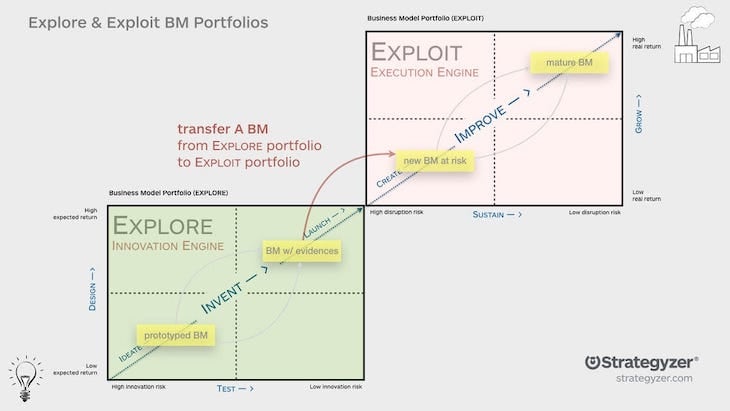What does innovation look like for you?

As a kid, I thought that geniuses saw what no one else could. I felt that innovators had out-of-the-blue insights that transformed the world. That was very naïve of me.
In Brazil, we have a saying for successful people, “You only see the drinks they enjoy, but you miss the failures they endure.”
Innovation is like that. It doesn’t happen overnight, even though most people only pay attention to success. Innovation comes from a number of failures and a willingness to persevere.
Although you cannot predict outcomes, you can implement strategies that maximize your potential. In this article you will learn the characteristics that innovative companies generally have and how they use them to continuously innovate and disrupt markets.
To understand what makes up an innovation culture, let’s look at some companies that have been at the forefront of business development.
Amazon started out as a way to sell books online. It evolved from a bookstore competitor to the biggest online shopping marketplace worldwide. Recently, it’s also steadily growing in cloud computing and space.
Apple started with computers, then disrupted the music and phone industry. Less than a decade ago, Apple joined the watch business, and today it sells more watches than all Swiss companies combined.
Both Apple and Amazon have an innovation culture, which allows them to continuously expand their product offerings and market reach. But, how does that happen? Alexander Osterwalder, a Swiss business theorist, describes their approach through his terms explore and exploit:
The following image describes this approach:

Even Amazon and Apple aren’t successful all the time.
Cultivating an innovation culture requires making several bets and understanding that many will result in losses.
Once, Jeff Bezos surprised a reporter by saying, “At Amazon, we don’t tolerate failures. We have an experimentation culture. Where experiments have an expected result, if that’s not achieved, we discard the initiative and move to the next one.”
Amazon learned how to value failures by calling them experiments. Over the last few years, Amazon has faced many failures. One of the biggest was the Fire Phone, which went to the market and didn’t resonate. In less than a year, Amazon decided to take the product off of the market. They’ve had 60 more failures that you can read about in this article.
Apple also has had its share of failures, from PDAs to Game Consoles. And yet, they continue disrupting markets.
Innovation requires you to be comfortable with failure as a step toward success.
Innovative companies differentiate themselves on the basis of their workplace cultures. In order to facilitate this, companies prioritize innovation through four directions:
Ordinary companies search for the perfect match in terms of skill set and personality. They want their candidates to tick all the boxes.
Innovative companies search for game changers. They want people who think differently and are willing to take high risks in exchange for high rewards.
The interview processes at Amazon, Apple, and Netflix are intensive. They want only the most innovative people to come on board. Because of this, they look at more than just what you know, but also how you think and what you could become.
Ordinary companies want people to follow the rules and execute tasks.
Innovative companies want people to solve problems and achieve goals.
“It doesn’t make sense to hire smart people and then tell them what to do; we hire smart people so they can tell us what to do.” — Steve Jobs
Innovative companies require innovative leaders that know the strengths of their employees and create a space where innovation can occur. This means granting autonomy and listening to what team members have to say.
The command and control approach doesn’t allow room for innovation. On the contrary, leaders lead by context. They share what matters, goals, constraints, and conditions, and they empower teams to play the game.
Ordinary companies rely on well-defined processes to coordinate their collaboration.
Innovative companies rely on self-managing teams to define how they work.
Netflix’s culture can be summarized in two words: freedom and responsibility. The company allows employees to do as they see fit, including taking as many days off as they want, while they continue to deliver results. Netflix is famous for disliking rules and seeking to empower employees and hold them accountable for results.
To innovate, you need to let teams figure out what works best for them. Leaders don’t need to define how teams work. Rather, they need to orient their teams toward business goals, while trusting them to follow their own path.
Ordinary companies focus on delivering solutions. All their energy goes towards output, and they reward those who meet their deadlines.
Innovative companies focus on solving problems. They look at the same problem from different angles to solve it innovatively.
Naturally, companies want to deliver solutions, but this mindset has started to get out of hand. Often people without any contact with customers define which solutions teams should implement. This format relies on luck, and tends to be costly when it goes wrong.
Innovative companies strive to find common problems and then transform how people solve them. Larry Page, the founder of Google, does what he calls a toothbrush test when acquiring a company. He looks for something that people use once or twice a day.
As an example, let’s imagine a taxi company in 2008. You may say calling a cab was annoying. In dealing with this problem, an ordinary company would find a better way of reaching cabs. An innovative company like Uber would look at the problem from multiple angles and create a better experience. That’s what they did. Uber created a new way of moving from A to B, and as a result, it disrupted that industry.
Developing an innovation culture is demanding. It requires changing how we think and how we perceive failures.
One of the biggest challenges is balancing between taking risks and ensuring stability. You cannot afford risks exclusively in the same way you cannot afford only stability.
To solve this challenge, separating exploration from exploitation is the answer. And it’s fundamental to understand the difference between them:
I was wrong as a kid to think innovation depended on a single genius coming up with insights and transforming the world. Innovation requires a string of failures before you finally achieve success.
A mindset that relies on delayed gratification, resilience, and persistence will increase the odds of innovation.
Featured image source: IconScout

LogRocket identifies friction points in the user experience so you can make informed decisions about product and design changes that must happen to hit your goals.
With LogRocket, you can understand the scope of the issues affecting your product and prioritize the changes that need to be made. LogRocket simplifies workflows by allowing Engineering, Product, UX, and Design teams to work from the same data as you, eliminating any confusion about what needs to be done.
Get your teams on the same page — try LogRocket today.

Promotions depend on proof. This guide shows PMs how to capture wins, feedback, and impact before review season.

Most teams fail at autonomy. Learn how clear rules help product teams move faster without micromanagement.

A practical framework for PMs to use AI in ideation without sacrificing judgment, strategy, or decision quality.

A practical five minute revenue estimation method to help product managers compare ideas, drop low impact features, and prioritize smarter.